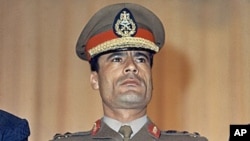Former Libyan leader Moammar Gadhafi has been killed by provisional government forces, bringing an end to his 40-year autocratic rule. The relationship was rocky between Washington and Tripoli during the past four decades.
Gadhafi came to power on September 1, 1969, leading a bloodless military coup that toppled Libya’s King Idris, who was out of the country receiving medical treatment.
Bruce St. John, an author of seven books on Libya, says early on, relations between Gadhafi and the United States were generally good.
“In the early years, he was very much focused on Arab nationalism, Arab unity, Arab socialism. And in fact, the United States government in the first two or three years - maybe even until 1974 - there were people in the United States government who thought we could work with the man and work with his regime. It was only later that he began to employ terrorist-type techniques, not only in North Africa and the Middle East, but eventually throughout the world,” said St. John.
Attempted Arab unity
Analysts say during the 1970s, Gadhafi tried to unite Libya with other Arab countries - but to no avail. Experts say it is also at this time that he began to provide aid to organizations considered by some governments to be terrorist - such as the Irish Republican Army and the Abu Nidal Group.
Relations between Washington and Tripoli reached an all time low during the Reagan administration. President Reagan called Gadhafi “the mad dog of the Middle East.”
St John said two incidents brought about the ire of the United States. In December 1985, terrorists attacked the Rome and Vienna airports. And in April 1986, two American soldiers were killed after a bomb went off in a popular West Berlin discotheque favored by U.S. servicemen.
“Gadhafi and his regime - the evidence was somewhat murky - but the United States government believed that they were involved in both of those instances. And it was particularly the La Belle discotheque incident that led the Reagan administration to take a decision to punish the Gadhafi regime and put it on notice that we would no longer tolerate that kind of activity,” said St. John.
In mid-April 1986, U.S. warplanes hit targets in Benghazi and Tripoli, including Gadhafi’s personal compound. Dozens of people were killed, including the Libyan leader’s adopted daughter.
Lockerbie bombing
Several years later, suspected Libyan agents planted a bomb that blew up Pan Am flight 103 over the Scottish town of Lockerbie, killing 270 people, many of them Americans.
“The Lockerbie bombing took place in 1988. There was a subsequent bombing in 1989 of a UTA flight over Niger on the way to France. The two attacks led the United States, Great Britain and France to move towards sanctions in the United Nations on Libya, after the Libyan government refused to hand over the suspects in those instances," said St. John. "That began in 1992. And those sanctions remained in place until the end of the decade, when the Gadhafi regime finally turned over the two suspects in the Lockerbie bombings, one of which was subsequently convicted.”
The man convicted in 2001 was Abdel Baset al-Megrahi.
St. John said there was quite an uproar - especially from the Lockerbie families - when in 2009, the Scottish government released al-Megrahi on compassionate grounds, saying he had terminal prostate cancer.
“At the time, the belief of the Scottish government, at least the belief that they articulated to the general public, was that he was likely to die within three months. And of course now, he is still alive, which throws into question what the decision was based on, what the medical evidence really looked like and so forth,” said St. John.
Gadhafi's 'rehabilitation'
Analysts say in 2003, Gadhafi made a dramatic turnaround. First he agreed to pay the final amount of money due the families of the victims in the Lockerbie disaster. And second, he announced Libya was renouncing its weapons of mass destruction program and the missiles required to deliver them.
Edward Djerejian, former U.S. ambassador to Syria and Israel, said Gadhafi realized he was in a precarious position.
“Remember, in 2003 we still very much thought that Saddam Hussein had weapons of mass destruction. And when he [Gadhafi] saw that the United States launched a military invasion of Iraq to topple Saddam Hussein’s regime, he saw the handwriting on the wall that maybe he would be next. And that certainly caught his attention. And then he did make this reversal of policies and it did lead to an accommodation with western countries,” said Djerejian.
Several years later in 2006 the U.S. restored diplomatic relations with Libya, but an ambassador arrived in Tripoli only in 2009.
The United States has recognized Libya’s National Transitional Council as the country’s legitimate government. Analysts say the Council has a daunting task ahead as it begins to rebuild a country scarred by 40 years of autocratic rule.












